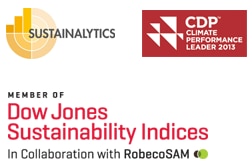Operational excellence
Operational excellence is an important part of the strategy and a pre-requisite for sustainable profitability. The Group is leveraging on its global strength and size to increase efficiency and lowering the cost base.

Electrolux continually strives for operational excellence by restructuring production, leveraging on its global scale, reducing tied-up capital and improving efficiency within sales and administration.
Competitive manufacturing
Since 2004, the Group is gradually restructuring its production through a thoroughly planned manufacturing footprint project that is planned to be finalized by 2016. About one third of the Group’s manufacturing has been moved, primarily from Western Europe and the US, to new production centers. 17 factories have been closed, 6 have been downsized and 11 new production centers have been opened, mainly in low-cost regions. These new production centers have been established both to reduce costs and to support strategic growth markets in Asia, Mexico, Latin America, Eastern Europe and Northern Africa. In 2013, 66% of the manufacturing was carried out in low-cost regions. The corresponding figure for 2004 was 28%. The total capacity utilization today is above 60% and when the manufacturing footprint project is finalized it will be at 75% with an ability to temporarily increase to meet demand peaks.
During 2013, a new cooker plant was opened in Memphis, Tennessee in the US, and a refrigerator plant was opened in Rayong, Thailand. A decision was taken to close down the plant for refrigerators and freezers in Orange, Australia, and to concentrate production to the plant in Thailand. In Latin America, integration continued of the manufacturing units in Argentina and Chile, which were added through the acquisition of CTI in 2011. A corresponding integration was conducted in Egypt for those units added through the acquisition of Olympic Group. In Europe, a review of the manufacturing footprint in Italy was initiated and a number of product lines were moved from factories in Western Europe to Eastern Europe.
A number of programs aimed at enhancing production efficiency are in place within the Group. Since 2005, the Electrolux Manufacturing System (EMS) has been implemented and encompasses all production units. The program focuses on continuous improvements in terms of product quality, costs, inventory reduction, employee safety and environmental impact. Of a total of about 50,000 production employees, almost half are certified at some level under EMS.
The results of EMS continued to be successful during the year. The manufacturing cost (conversion cost) per manufactured unit for major appliances has declined with 25% since 2010, and since 2005, energy usage per produced unit has decreased by 41%.

Proportion of production in low-cost regions

Leverage on scale – Global Operations
The major activities to leverage and benefit from the scale of the Group are:
- Coordinated purchasing for raw materials, components and finished products. Recently indirect purchasing has been added to this initiative. Currently, the global purchasing function coordinates and monitors 60% of all purchasing, and the ratio will increase further.
- Faster and more efficient processes for product development through global, cross-border units for product development, design and marketing.
- Lower product development and product costs by using standardized global modular platforms for new products. This also creates speed in the product development process, and the target is to reduce time-to-market with 30% and the number of variants with 20%.
In 2013, the initiatives continued to yield clear results. Modularization in various product groups accelerated and now covers 10% of all direct material costs for manufacturing of the Group’s products. Developing products based on global platforms leads to greater efficiency not only in product development and marketing, but also in production, since fewer product platforms are required.
Profitable growth in all segments

Capital efficiency
For several years, Electrolux has been working intensively to reduce tied-up capital in the Group. In addition to Group-wide measures to streamline and optimize manufacturing, each business area is working on reducing working capital to release resources that can instead be invested in growth activities. The work focuses on efficiency-enhancement measures in primarily four areas: trade receivables, accounts payable, inventory and procurement. The working capital program has resulted in an increase in the capital turnover-rate and a reduction in structural working capital.
The structure of the capital expenditure in the Group has also changed over the last five years to more expansionary investments and less maintenance investments. Investments in product development have more than doubled and investments in factories have been cut by 50%.
Sales costs and administration
Efficiency within sales and administration is driven by the following activities:
- Common IT-systems. Europe has now fully implemented a new ERP. Asia/Pacific is currently performing a refresh of the present ERP and for North and Latin America projects will start in the period 2015-2016.
- Shared service centers for Finance and Accounting are implemented in Europe, Asia/Pacific, North America and Latin America and optimization of the processes are on-going.
- Continuous overview and merger of legal entities to create a shared infrastructure and back office in all regions.
- Deployment of efficient and common go-to-market tools and processes.
Net operating working capital

Capacity utilisation in manufacturing

CEO Statement

In 2013 we continued to deliver above our growth target and delivered 4.5% in organic sales growth.
CEO Statement

I'm convinced that raising product efficiency for the growing middle class is where long-term shareholder value creation lies.
Our products

Electrolux is the only appliance manufacturer in the industry to offer complete solutions for both consumers and professionals. The focus is on innovative and energy-efficient products in the premium segments.
Sustainability
Achieving the Group's vision of sustainability leadership is crucial to realizing the business strategy. The objective is to develop smarter, more accessible, resource-efficient solutions that meet people's needs and improve their lives. Read the comprehensive sustainability performance review.
Awards & recognition

Financial Reporting
Net sales for the Electrolux Group in 2013 amounted to SEK 109,151m, as against SEK 109,994m in the previous year. The organic sales growth was 4.5%, while currencies had an impact of -5.3%.
